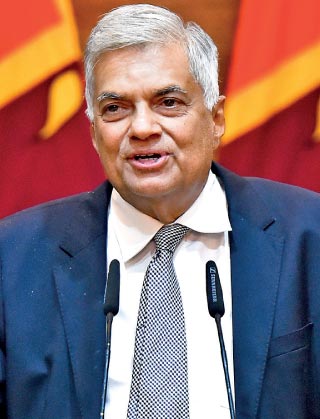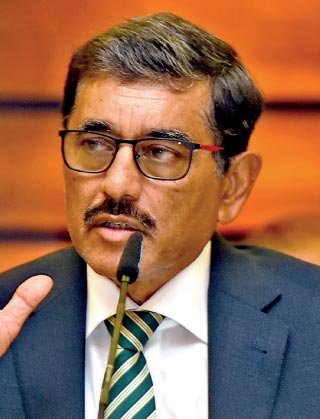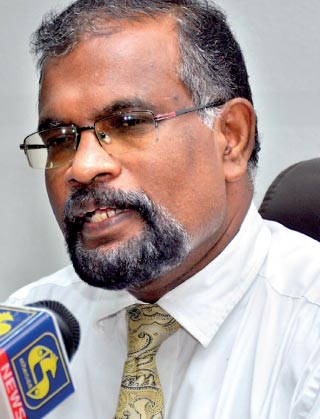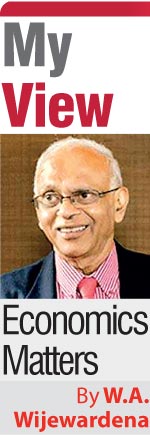Friday Nov 28, 2025
Friday Nov 28, 2025
Monday, 29 August 2022 02:06 - - {{hitsCtrl.values.hits}}

President Ranil Wickremesinghe

Central Bank Governor Dr. Nandalal Weerasinghe

Treasury Secretary Mahinda Siriwardana
|
 The call for an independent central bank
The call for an independent central bank
The US Senate Foreign Relations Committee, a Senate organ that has existed for more than 200 years, has spelt out in a Twitter message some of the conditions that should be satisfied before an IMF bailout is extended to Sri Lanka (available at: https://twitter.com/sfrcdems/status/1542979994892357633?s=21&t=tQymKMnop1-sO0OPGJnU6Q). One such condition is that Sri Lanka’s Central Bank should be made independent. This has been one of the preconditions stipulated by IMF too. Though Central Bank’s independence is a matter which Sri Lanka’s citizens should take up, in this case, it is outside bodies that specify this vital requirement.
I revisited Central Bank’s independence when I delivered the 68th Anniversary Oration of the Bank in 2018. The text of the oration can be found at https://www.cbsl.gov.lk/sites/default/files/cbslweb_documents/press/pr/speech_20180828_68th_Anniversary_Oration_e.pdf. The oration can be viewed here: https://www.youtube.com/watch?v=2DWd4LdcJrw&t=1s. Later in 2019, I delivered a public lecture on central bank independence at the Bank’s Centre for Banking Studies (available at: https://www.youtube.com/watch?v=IIO6UWkqrZw). Given the importance of the Central Bank independence today, it is useful to revisit the topic once again.
Central banks are an organ of society and not of the government
Central banks have been created by societies to preserve the value of the money it produces. Hence, they are to serve the people and not the political authorities in power. This has been a contentious issue which has been downplayed by political authorities. But its independence is a matter for concern. This is because a central bank today produces money out of nothing as if a magician creates a rabbit by waving a magic wand. This money has no intrinsic value of its own. The value comes from its ability to facilitate the owner to acquire a real basket of goods and services. They are called ‘real’ because they enable the owner to consume them directly or use as an input for producing a further output.
Because of this promise, people agree to exchange the real assets they own for the paper money which a central bank produces on behalf of a government. Though the government is the institution behind the creation of a central bank, it is supposed to allow a central bank to produce money in accordance with the mandate which Parliament has given it.
Mandate of central banks is to preserve the value of money
That mandate requires a central bank to supply money in sufficient quantities at the correct time to facilitate the exchange of the output produced by the economy without disruption. Hence, money printing by a central bank is not evil at all times as popularly believed by many. The problem arises if a central bank produces more money than necessary. In that case, the excess money will lead to creating an excess demand for goods and services with two interrelated outcomes.
One is the tendency for prices to go up causing a decline in the size of the real basket of goods and services which people can command by using money. The other is the leakage of that excess money out of the country through increases in the demand for imported goods and services. If the country does not earn enough foreign exchange to meet that demand, it leads to creating balance of payments difficulties, exerting pressure for the exchange rate to depreciate. Hence, both inflation and exchange rate depreciation are the result of a central bank producing more money than necessary.
Play the game of money printing prudently
Accordingly, a central bank is required to play the game of money printing according to a set of prudent rules. If it does so, it can earn the trust of the people. If it does not, it loses their trust as well as its ability to get people to accept the money it produces. As such, a central bank should have freedom to decide how much money it should produce without the interference of outside parties. This freedom, in laymen’s language, is paraphrased as the right of a central bank to say no, when there is pressure from the government or any other party to produce money in excessive amounts. When the central bank says no, it becomes unpopular because everyone out there want it to produce more money. This was beautifully put by a former Chair of the US Federal Reserve System, the central bank in that country, William McChesney Martin. Jr., that the job of the Federal Reserve was to take away the punch bowl just as the party gets going.
Fate of Swedish central bank
The world’s oldest existing central bank, Sweden’s Sveriges Riksbank, established in 1668, ran into problems when it refused to finance King Gustav III’s military expeditions against Russia in 1788. The King reacted to the independence demonstrated by the Riksbank by issuing his own currency through The Swedish National Debt Office. It pushed the Riksbank to the backwater till 1802. That was surely a too high a price which a central bank had to pay for refusing to accede to the demands of a recalcitrant political leader.
Keynes was for central bank independence
Since then, the independence of central banks was valued by academia who wrote on central banking. For instance, John Maynard Keynes who was a part of the Chamberlain Commission of 1913 on India’s Financial System submitted a memorandum on the invitation of other commission members on the establishment of a shareholder owned central bank. This new bank, proposed to be called the Imperial Bank of India, was to be established by amalgamating the three Presidency Banks that had existed in Calcutta, Bombay and Madras. Keynes advised that the Secretary of the State, though he was the official behind, has only the final word about the work of the bank. Thus, he was the adjudicator of last resort.
Its day to day operations, as recommended by Keynes, should be free from the interference of both the government and the shareholders, since it might run counter to the general interest. In today’s context where central banks are owned by governments, what this means is that they should be free from the interference of political authorities.
However, with the onset of the World War I, Keynes’ wisdom could not be carried forward. It was in 1935 that the Reserve Bank of India was setup as a shareholder owning bank with independence and once it was nationalised in 1949, it got relegated to an institution that “traditionally functioned as an arm of the government” prompting Governor C. Rangarajan to call for greater autonomy for the bank in a public lecture in 1993.
Is RBI independent?
Recently, it was the former Governor of the Reserve Bank of India, Dr. Y.V. Reddy, who succinctly related the exact status of the independence of that central bank. Addressing a forum in Chennai in December 2017, Reddy is reported to have said that a central bank being the creation of the government can never be independent of the creator. Governor Reddy is at fault here because he has misidentified the government as equivalent to the sovereign state. It is the state that has created the central bank to serve people just like it has created the government also to do the same in a different capacity. Hence both are two arms of the sovereign state and one arm cannot subdue the other arm by using its powers.
Addressing another forum earlier in Hyderabad, Reddy had recalled how he answered the question raised by a journalist in 2008 when he was holding the office whether the Governor of the Reserve Bank of India was independent. He had told the journalist: “The RBI Governor is very independent; I took the permission of my Finance Minister to say this.” This shows how Ministers of Finance have made central bank governors their own mouthpieces.
Central banks are more independent today than earlier
Central banks today enjoy a degree of independence ranging from full autonomy to partial autonomy. The global trend has been to go for greater independence in central banks within the last two to three decades. This trend has been supported by the realisation that greater autonomy in central banks helps countries to fight inflation more successfully. But this has not been the consensus among the mainstream economists. Some have given pre-qualifications such as the presence of strong institutions for an independent central bank to operate successfully. Others have raised the issue of independent central banks failing to avert the financial crisis of 2007-8. Thus, according to these groups, independence is irrelevant and unnecessary to tackle today’s problems.
However, a study conducted by Marco Arnone and others in 2007 (available at: http://citeseerx.ist.psu.edu/viewdoc/download?doi=10.1.1.367.6837&rep=rep1&type=pdf) has revealed that, while all central banks have improved their political and economic autonomy over the years, some central banks in the developed world, namely, Australia, Denmark, Iceland, Sweden, Norway, Switzerland and UK, enjoy full autonomy. According to this study, Sri Lanka’s central bank which has scored 0.5 out of 1.0 is categorised as a bank enjoying partial autonomy.
Finance Secretary sitting on the Monetary Board as a vote-carrying member
One of the key issues relating to the independence of the Central Bank has been the placement of the Secretary to the Ministry of Finance as a vote carrying member on the Monetary Board in terms of the Monetary Law Act as proposed by John Exter, the architect of the Bank. The criticism has been that the Finance Secretary acting in self-interest would get the Bank to fund the budget through accommodative monetary policy, thereby causing fiscal policy to override monetary policy.
The past experience of the Central Bank shows that this criticism has some validity. But Exter’s wisdom was to create an environment for both the government and the central bank to have a peaceful and amicable cohabitation. Exter argued in his report that “… there are, however, many important problems of monetary policy, especially those relating to fiscal policy, on which a central bank should work in close harmony with the government”.
CBSL has a limited degree of independence
Accordingly, a degree of independence has been afforded to the Central Bank of Sri Lanka unlike other governmental bodies. This independence extends to the budget of the bank, job security of key central bank officials and power to make monetary policy without consulting the government. The wisdom of Exter was that the Central Bank should as far as possible work in consultation with the government, rather than in isolation. He believed that the true independence of the Central Bank could be preserved only through that consultative process.
In the words of Exter, “the ideal is…one in which there will be continuous and constructive co-operation between the monetary board and the government. The principal instrument for achieving this co-operation should be the permanent secretary to the Ministry of Finance whose membership on the board will ensure at all times that his Minister’s views will be known to the other members of the board”.
However, Exter did not expect this arrangement to be effective at all times. Hence, he made the proviso that “it would depend on the men occupying the key positions” and not on any legal formula. He argued quite correctly that such complex and delicate relationships cannot be established full-blown by a piece of legislation. It must be the result of years of experience and the slow growth of political conventions.
Permanent secretaries are no longer permanent
Exter report testifies to the fact that the independence of the central bank should be attained and maintained by people in both the central bank and the Ministry of Finance. They should work with a ‘moral consciousness’ regarding the wellbeing of the whole society. Any attempt at seeking narrow self-interests will be contrary to this moral consciousness. Exter had a noble objective that the permanent secretary of the Ministry of Finance will guide his Minister appropriately and independently. But that objective was defeated by the 1972 Republican Constitution which abolished the post of permanent secretary in the public service.
Instead, the constitution created a post of secretary which was under the control of the Cabinet of Ministers. Hence, in today’s context, the secretary to the Ministry of Finance sitting on the monetary board is not an independent member. He is a public official who will seek to lead the monetary board in accordance with the wishes of the Minister of Finance. Hence, a serious question has arisen today with respect to the independence of the Central Bank.
Maturity of central bankers
Exter’s point was that the maturity of people and growth of guiding conventions were needed for the success of the Central Bank. This is in accord with the role of institutions in making a central bank a successful outfit as presented by Daron Acemoglu and others in an NBER Working Paper published in 2008 (Paper No. 14003). According to them, the presence of a supporting institutional structure was a sine qua non for economic policy to work in an economy. Institutions in institutional economics are not just organisations. They refer to “rules, enforcement characteristics of rules and norms of behaviour that structure repeated human interactions”.
Accordingly, a society with strong institutions has members with high values and ethos that are built into a self-governing governance system. When the central bank as well as the Ministry of Finance is run by such people, as envisaged by Exter, the question of Bank’s independence does not arise. The presence of such a perfect situation not only leads to the development of a cohesive policy infrastructure but also helps both the government and the central bank to achieve their respective objectives without running into conflicts and battling with each other.
Central banks’ challenge to remain relevant
It is, therefore, clear that the independence of a central bank cannot be ensured just by a legal arrangement. It is dependent on how those in the central bank view independence as a necessary safeguard, on the one hand, and the appreciation of that stand of the bank by all others, on the other. At the core of this independence, therefore, lies the bank’s freedom to decide on the appropriate level of money which it has to produce and supply to the economy. The experience throughout the globe has shown that the central banks which have produced more money than necessary have got into trouble by causing inflation to destroy their economies and having to go through painful currency reforms.
In the past, it was just writing off a few digits from the face value of currency notes or introducing a new series of currency notes at new values. But today, with the proliferation of crypto-currencies competing with central bank produced money, the challenge has been for central banks to remain relevant in their respective economies.
Central banks should be wary of pressure groups
The latest case in point is that of Venezuela which had to write-off not only five digits from its currency but also to introduce its own crypto-currency named Petro to fight hyperinflation in the country. Thus, the management of a central bank – Governor and the board – should be careful about those who have an interest in getting it to compromise its independence. There are three groups falling into this category, the political authorities, pressure groups in the market place and its own employees. Political authorities may need the bank to print more money to keep the electorate satisfied so that they could win elections.
Pressure groups seek to earn a rent by getting a central bank to offer a favourable credit policy, a situation known as ‘regulatory capture’. Employees may agitate for enhanced compensation packages over and above the increase in labour productivity in a central bank. Since the only power enjoyed by a central bank is to print money, acceding to the demand of any of these groups will be disastrous for fulfilling its mandate.
Central bank independence is more relevant to Sri Lanka today
Sri Lanka’s inflation rate is rising at 55% annually according to the underreported Colombo Consumers Price Index or CCPI. When the National Consumers Price Index or NCPI covering the whole island is released later this month, it is estimated that the national inflation will be around 60%. This rate is on the increase, and it is expected that inflation rate will be around 75%-80% in two to three months’ time. This is the outcome of the past money printing which the previous central bank management has done to satisfy their political masters.
Now that both the US Senate Foreign Relations Committee and IMF have laid down that the Central Bank should be an independent institution, Sri Lanka’s political leaders should not ignore it anymore. To make their work easier, there is already a draft central banking act that had been prepared by the Central Bank’s previous management. The present Government should retrieve it from the archives, update it to reflect the present-day requirements, and enact it as soon as possible.
(The writer, a former Deputy Governor of the Central Bank of Sri Lanka, can be reached at [email protected].)